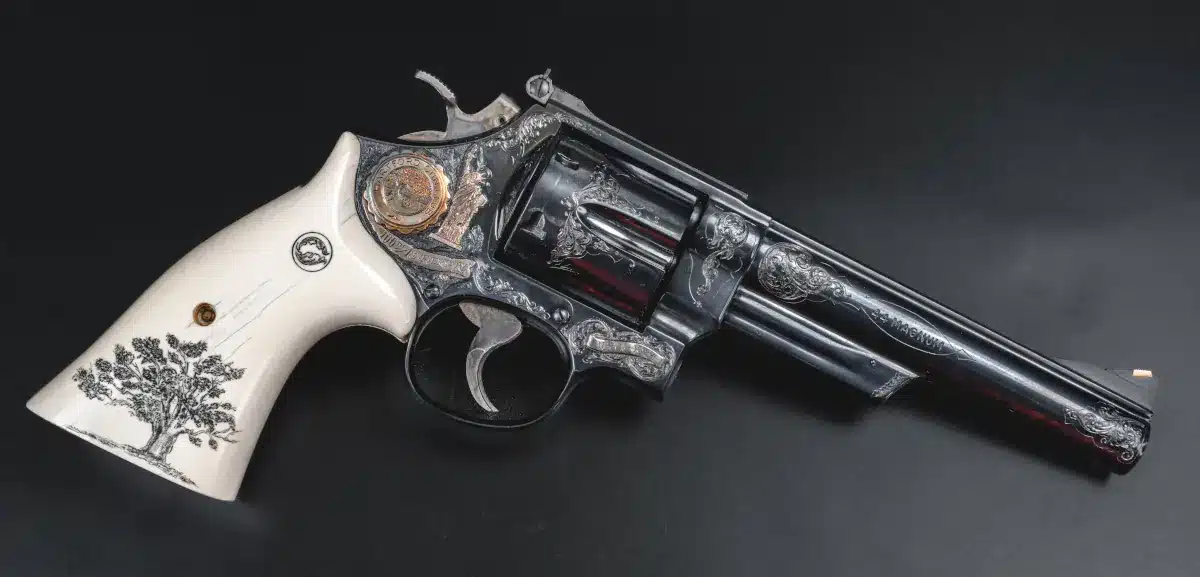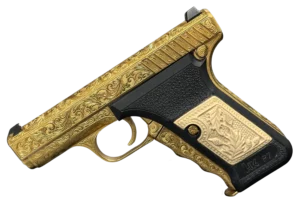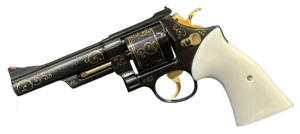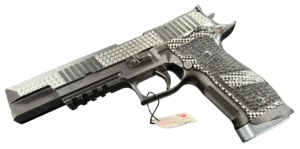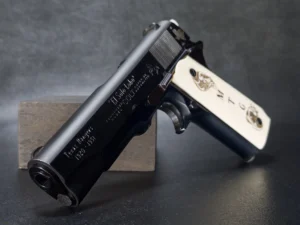Key Takeaways:
- Smith & Wesson didn’t just keep up with history — they helped write it: From inventing cartridge ammo to arming soldiers in two world wars, S&W has always been more than just a gun company. They’re a thread in the fabric of American innovation — gritty, bold, and always a step ahead.
- The company’s real strength? Balancing power with responsibility: Whether it’s the .357 Magnum shaking up law enforcement or the internal locking system sparking debates about safety, S&W constantly walks the line between performance and accountability — and they’re not afraid to evolve.
- This legacy isn’t locked in a display case — it’s still alive: From Dirty Harry’s Model 29 to the M&P M2.0 on today’s shelves, Smith & Wesson hasn’t lost its edge. They’re still making guns that work, matter, and — let’s be honest — make people feel something when they pick one up.
Say the name out loud — Smith & Wesson — and chances are, someone’s ears perk up. Maybe it’s a collector’s ears. Maybe it’s a cop’s. Maybe it’s your uncle who won’t shut up about “his trusty .38.” Point is, this brand has been around so long, and meant so much to so many different people, that it’s practically stitched into the American story.
And honestly? That story’s worth telling.
This isn’t just a company that cranked out guns. It’s a name that’s been tied to innovation, war, peace, movies, myths — you name it. From the gritty factories of the 1800s to sleek semi-autos and hand-tuned revolvers in custom cases, Smith & Wesson has managed to keep things moving, keep things evolving, and still somehow keep its soul intact.
So let’s talk about it — not with museum-glass detachment, but like two people sitting down with a cup of coffee (or a bottle of something stronger), digging into a legacy that’s still being written.
How It All Kicked Off — And Why It Mattered
Picture this: 1852. The Gold Rush is still buzzing, steam locomotives are huffing across a young America, and two guys — Horace Smith and Daniel B. Wesson — decide they’re going to change how firearms work.
That’s a tall order.
Back then, firearms were mostly slow, clunky muzzleloaders. Load the powder. Ram the ball. Hope for the best. But these two had bigger ideas — like “what if you could load a round all at once?” Their work on cartridge-based ammunition was, frankly, a game-changer. Not just for convenience, but for the entire concept of modern shooting.
Then came the Model 1 revolver — the first commercially available revolver using rimfire cartridges. It wasn’t some massive battlefield cannon. It was small. Personal. Practical. Suddenly, people could actually carry a reliable sidearm that didn’t feel like dragging a musket around in your waistband.
And with that, Smith & Wesson was off to the races.
Ammo That Changed the Game: The .38 Special and the Magnum Mindset
If you’ve ever handled a .38 Special, you’ve felt the quiet confidence of a round that just… works. It was 1898 when S&W introduced it, mainly to give law enforcement something a bit more serious than the underwhelming .38 Long Colt. It turned out to be the right call.
The .38 Special wasn’t flashy — but it hit that sweet spot between recoil and power. It became a law enforcement staple, a civilian go-to, and a favorite for target shooters. Reliable, accurate, and easy to manage.
But then came the .357 Magnum.
Now this — this was a flex.
Developed in 1934 with help from ballistic savant Phil Sharpe, the .357 wasn’t just a little more powerful. It was a lot more powerful. Like “this’ll punch through a car door” powerful. It gave cops the edge they were looking for, especially during a time when bad guys were running around with Tommy guns and cars that doubled as armor.
Together, the .38 Special and .357 Magnum didn’t just fill gaps in the market — they redefined the standard.
The M&P Series: Law Enforcement’s Unofficial Uniform
There’s something poetic about a gun becoming part of a uniform. Like a pen for a writer or a wrench for a mechanic, Smith & Wesson’s Military & Police (M&P) line became part of the everyday toolkit for cops across the country.
First released in the early 1900s, the M&P series wasn’t trying to be flashy. It was built to be dependable. Something you could draw in the rain, in the dark, when adrenaline’s pumping and your hands won’t stop shaking — and still hit what you needed to hit.
It earned trust fast. Departments began standardizing around it. Officers trained with it, carried it for decades, and many retired with the same sidearm they started with.
Fast-forward a few decades, and the M&P line has evolved. Semis, rifles, polymer frames, striker-fired systems — Smith & Wesson didn’t get stuck in the past. They adapted. The name stayed the same, but the tech kept moving forward.
Big Iron: The Model 29 and the Rise of the Magnum Era
You know that famous line — “Do you feel lucky, punk?”
Yeah. You do.
Dirty Harry didn’t just make the Model 29 famous — he made it a legend. Chambered in .44 Magnum, the Model 29 hit the scene in 1955 and was basically the nuclear option of handguns. Designed in part thanks to Elmer Keith, the .44 Magnum round was so powerful, some folks didn’t believe a revolver could handle it.
But it did. Beautifully.
Hunters, long-range pistol shooters, and — eventually — moviegoers were mesmerized. The Model 29 was heavy, sure, but it was also elegant. It had lines. It had presence. Holding one feels like gripping history, weight and all.
Today? It’s still a bucket-list gun for collectors. And it still kicks like a mule.
Safety Meets Style: How S&W Balanced Innovation and Responsibility
Here’s something not everyone talks about when they get into guns: safety innovation. Not exactly the sexiest topic, right?
But Smith & Wesson didn’t shy away from it. One of their more controversial moves was the internal locking system — a built-in mechanism that could disable the firearm when engaged. Some folks love it. Some… not so much. Either way, it showed the company was thinking beyond just selling firepower. They were trying to consider what responsibility looked like, too.
Then there’s the Performance Center. That’s where the real fun starts.
Imagine a custom shop run by obsessive gun nerds who live and breathe trigger feel, barrel crown geometry, and finish tolerances. That’s the Performance Center. These are the guns that show up with hand-tuned triggers, ported barrels, slick finishes — the kind of details that make shooters grin after the first squeeze of the trigger.
It’s where safety, beauty, and performance meet. And yes, they’re not cheap. But good things rarely are.
Two World Wars, One Reputation
Let’s be real — when your products go to war, they’d better work. And Smith & Wesson’s did. During both World Wars, S&W revolvers — particularly the Victory Model — saw heavy use by Allied forces. They weren’t the flashiest tools on the battlefield, but they were dependable.
And that matters a lot more than flash when you’re in a trench, trying to survive.
Those wartime models are now collector gold. Not just because they’re rare (although that helps), but because they carry stories. Battle scars. History you can hold in your hand.
To this day, they remind people of a time when American factories churned out weapons not just for defense, but for freedom. Big words, sure — but in this case, kinda hard to argue.
Revolver Evolution: From Snap-Open to Side-Swing and Beyond
Back in the day, revolvers used a top-break design. Flip the barrel down, and all the empties came out at once. It was clever. Efficient. But also kinda fragile under heavy use.
Enter the side-swing cylinder.
This update made revolvers tougher, easier to reload, and more adaptable to higher-pressure rounds. It’s basically the format we still use today. And, of course, Smith & Wesson was leading the charge.
But they didn’t stop there. Materials changed. Steel got swapped for scandium and titanium — fancy metals that made revolvers lighter without sacrificing strength. A .357 Magnum in a lightweight frame? Now that’s something to talk about.
If you’re into revolvers, S&W’s evolution over the decades is like flipping through the best kind of photo album — one where every page shows how form follows function, but still leaves room for a little swagger.
Hollywood Royalty: When Guns Become Pop Culture
Smith & Wesson didn’t just show up in history books — they made it into movie posters.
From gritty Westerns to modern action flicks, their guns have been in more scenes than most actors. The Old West loved its S&W top-breaks. And once the silver screen hit color, you couldn’t miss that Model 29 gleaming in Harry Callahan’s hand.
It’s more than just product placement. These guns had character. You saw them and knew what they were about — power, control, justice (or at least some version of it).
That kind of cinematic presence keeps the brand alive in pop culture — and in the imaginations of new generations of shooters, collectors, and movie fans alike.
Today’s Smith & Wesson: Still Evolving, Still Classic
Here’s the thing — a lot of brands ride their own coattails. Rest on old glories. Coast.
Smith & Wesson? Not so much.
Take the M&P M2.0 series. These are modern, polymer-framed, striker-fired pistols built to compete with Glock and other titans of the current handgun world. And they do. The ergonomics? On point. Triggers? Vastly improved. Durability? Solid.
And S&W hasn’t ignored the bigger picture either. They’re taking real steps toward more sustainable manufacturing, reducing waste, and cutting their environmental impact. A far cry from the smokestack-riddled days of the industrial revolution.
It’s a brand that’s honoring its past without getting stuck in it.
For the Curious: Whether You’re New, Seasoned, or Somewhere in Between
Let’s say you just bought your first Smith & Wesson. Cool. Now what?
Understanding how the thing works — not just how to shoot it, but how to clean it, fix it, store it — is part of the deal. S&W gets that. They’ve invested heavily in educational content, safety programs, and training resources. Doesn’t matter if you’re a first-time buyer or a grizzled range rat — you’ll find something useful.
And if you’re a teacher or history buff? Their archives are gold. These aren’t just guns — they’re artifacts. You can trace changes in American society by studying the rise of the revolver, the swing to semi-autos, the shift in police gear.
Whether you’re in it for function or fascination, there’s something to dig into.
Final Thoughts (But Not Really “The End”)
Trying to sum up Smith & Wesson in a few thousand words is like trying to explain jazz with a spreadsheet. You can hit the notes, but it misses the soul.
This is a company that’s more than its catalog. It’s a reflection of American grit, reinvention, and craftsmanship. Sure, it’s had its controversies. What long-running institution hasn’t? But through it all, it kept building. Kept improving. Kept showing up.
And if there’s one thing that defines Smith & Wesson, it’s that: they show up. In history. In holsters. In homes. In movies. In stories.
And if you’ve ever held one of their guns — really held it, understood it — you know that story isn’t over.
It’s still being written.
Frequently Asked Questions
What is the significance of Smith & Wesson in firearm history?
Smith & Wesson is one of the most influential firearm manufacturers in history. It is known for introducing groundbreaking designs and innovations that have shaped the modern firearms industry. Its revolvers, semi-automatic pistols, and law enforcement tools have set benchmarks worldwide.
What are some iconic Smith & Wesson models?
Some of the most iconic models include the Model 10 Military & Police revolver, the Model 29 .44 Magnum (famously used in Dirty Harry), the J-Frame revolvers, and the M&P series of pistols widely used in law enforcement and civilian markets.
How has Smith & Wesson impacted law enforcement?
Smith & Wesson has a long-standing relationship with law enforcement agencies. For much of the 20th century, they provided reliable sidearms like the Model 10 revolver for police officers. Their modern M&P (Military & Police) line continues this tradition with advanced semi-automatic pistols.
What are some significant innovations by Smith & Wesson?
Smith & Wesson pioneered the double-action revolver, introduced the first .357 Magnum, and developed high-capacity semi-automatic pistols. Their advancements in materials and design have also made firearms lighter and more ergonomic.
Why are Smith & Wesson revolvers so popular among collectors?
Smith & Wesson’s revolvers blend history, craftsmanship, and reliability, making them highly desirable for collectors. Limited editions, historical models, and finely engraved revolvers have become prized collector’s items.


